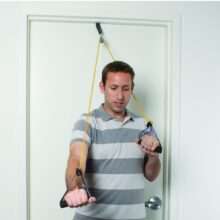Shoulder Finger Ladder
Login For Health Care Pricing
The Cando Shoulder Finger ladder is a wall mounted wood unit with 36 steps at 1 1/4″ intervals for shoulder, elbow, wrist, and finger: 2″W x 54″L.
The wall-mounted CanDo® Shoulder Finger Ladder offers progressive mobility of arm at shoulder, elbow and wrist joints. The wood unit has 36 steps at 1 1/4″ intervals for shoulder, elbow, wrist, and finger: 2″W x 54″L.
A shoulder finger ladder, also known as a shoulder ladder or a shoulder range of motion ladder, is a rehabilitation tool commonly used in physical therapy settings to improve shoulder mobility, flexibility, and strength. It consists of a vertical wooden or metal frame with a series of horizontal bars or rungs spaced apart at regular intervals, resembling a ladder. Here’s an explanation of what a shoulder finger ladder is and its key uses:
What Is A Shoulder Finger Ladder?
- A shoulder finger ladder typically consists of a sturdy frame that can be mounted to a wall or attached to a freestanding base.
- The ladder features horizontal bars or rungs arranged vertically, spaced at varying intervals to accommodate different shoulder exercises and ranges of motion.
Key Uses
- Shoulder Range of Motion Exercises: The primary use of a this exercise accessory is to facilitate a wide range of motion exercises for the shoulder joint. Patients recovering from shoulder injuries, surgeries, or conditions such as frozen shoulder can use the ladder to perform gentle stretching and mobility exercises to gradually increase flexibility and range of motion.
- Rehabilitation: Physical therapists use shoulder finger ladders as part of rehabilitation programs for individuals recovering from shoulder injuries, surgeries, or conditions affecting shoulder mobility. The ladder allows patients to perform controlled and guided movements to regain strength, flexibility, and function in the shoulder joint.
- Strengthening Exercises: In addition to improving flexibility and mobility, shoulder ladders can be used to strengthen the muscles surrounding the shoulder joint. Patients can perform various exercises, such as shoulder presses, rows, and isometric holds, using the ladder’s rungs as resistance.
- Neuromuscular Re-education: These ladders are also valuable tools for neuromuscular re-education, helping patients improve coordination, proprioception, and muscle control in the shoulder joint. Patients can practice reaching, grasping, and manipulating the ladder’s rungs to enhance motor skills and functional movement patterns.
- Postural Correction: Proper shoulder function is essential for maintaining good posture and preventing shoulder-related issues such as impingement or instability. Using a shoulder ladder can help patients correct postural imbalances and develop healthy movement patterns to support optimal shoulder alignment and function.
- Progressive Rehabilitation: These ladders allow for progressive rehabilitation, with patients gradually advancing through a series of exercises and increasing the intensity as their shoulder strength and mobility improve. Therapists can adjust the height and spacing of the ladder’s rungs to accommodate each patient’s specific needs and abilities.
In summary, a shoulder finger ladder is a versatile rehabilitation tool used to improve shoulder mobility, flexibility, strength, and function. Whether recovering from an injury, surgery, or seeking to enhance shoulder performance, patients and therapists alike can benefit from incorporating shoulder finger ladder exercises into a comprehensive rehabilitation program.






Commentaires
Il n'y a pas encore de commentaires